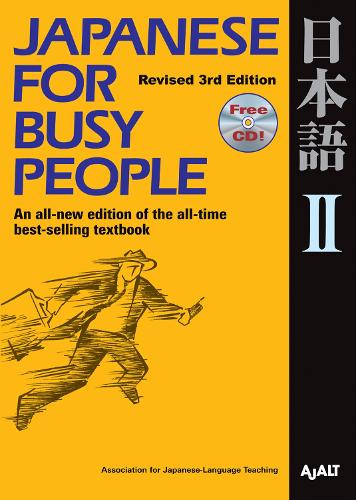
Japanese For Busy People 2
(Paperback, 3rd edition)
Available Formats
Publishing Details
Japanese For Busy People 2
By (Author) AJALT
Kodansha America, Inc
Kodansha America, Inc
11th November 2011
3rd edition
United States
Classifications
General
Non Fiction
495.682421
Physical Properties
Paperback
328
Width 191mm, Height 267mm
682g
Description
Volume I dealt with "survival Japanese" for tourists and other short-term travelers and newcomers to Japan. Volume II, meanwhile, turns to the basics of Japanese syntax. The book is by no means only about grammar, however. Rather, it is designed to help learners consolidate their understanding of syntactical structure through lessons that focus on how to talk about topics relevant to daily life. In addition to serving learners continuing from Volume I, Volume II will benefit those who have already studied beginning Japanese to some extent but wish to brush up on syntax. Major Features of Japanese for Busy People II, Revised 3rd EditionJapanese for Busy People II, Revised 3rd Edition will enable learners to progress smoothly through the equivalent of the latter half of a typical first-year Japanese course while gradually building speaking and listening skills. Learners approaching mid-beginner status often find themselves suddenly faced with syntax and vocabulary much more complex than what they have studied before. Such grammar and vocabulary do not appear as frequently in everyday conversation as those words and structures they have learned up to this point, necessitating that they spend ample time on review. Moreover, learners at this stage are expected to become familiar with verb tense and aspect, time expressions, conditional clauses, and other topics that require them to have a solid grasp of context and speaker intent if they are to fully understand the differences in meaning conveyed by each. Such points cannot be mastered by reading through grammatical explanations alone. In short, the mid-beginner level is a difficult one for many adult learners who, unlike students in school, have neither time nor opportunities to take repeated tests or to otherwise gauge their progress. Japanese for Busy People II, Revised 3rd Edition helps overcome the above obstacles through grammar and content topics carefully selected to be appropriate to learners at this level of Japanese proficiency. The book is designed so that by practicing talking about each topic, learners will gradually and effectively acquire sentence patterns and vocabulary related to that topic. Like Volume I, Volume II is organized into several large units, each covering topics grouped under a particular theme. In this way, the book enables learners to achieve a well-balanced understanding of grammar, sentence structure, and context. Themes and lesson objectives of the five units in Volume II are as follows. Unit 1- Souvenir Shopping Following up on Volume I, Unit 1 presents survival Japanese related to shopping, thus providing learners with a thorough review of simple clauses. The unit also goes beyond what was covered in Volume I by showing ways of asking someone's opinion while shopping, making comparisons between items, and describing an item's characteristics. The overall theme is "picking souvenirs," a subject that should be relevant to learners both in Japan and abroad. The verbal skills and dialogue patterns studied here may be applied not only to shopping but also more broadly to any situation that involves choosing between options. Unit 2- Building Rapport with Colleagues This unit introduces the plain forms of verbs - a crucial component of Japanese compound sentences - along with several sentence-final elements that make use of these forms. Topics are selected from among those that typically come up when interacting with people from work. Covered are constructions for indicating interest in another's actions, inviting someone to do something outside of work, asking for help or offering advice, and otherwise interacting with people in ways that help build relationships of trust and understanding. Unit 3- Returning to Japan for Work This unit explains how to build sentences using temporal
Author Bio
The Association of Japanese-Language Teaching (AJALT) was established to meet the practical needs of people who are not necessarily specialists in Japanese but who wish to communicate effectively. The AJALT was recognized as a nonprofit organization by the Ministry of Education in 1977.
